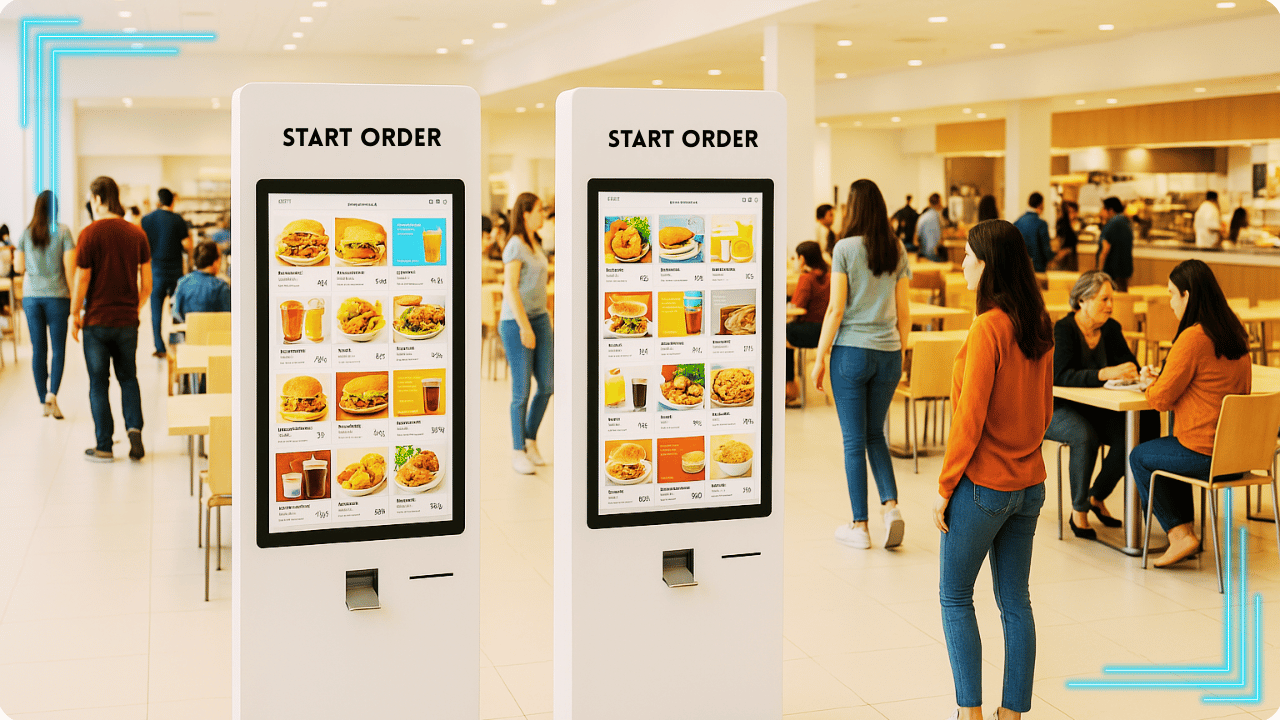
If you run a restaurant, diner, or burger shop, you’ve probably considered installing touchscreen ordering screens, right? To clear up any doubts, let’s explore exactly what a self-service kiosk is and how it can completely transform your customer experience.
Imagine a customer walking into your business, placing their order directly on a digital screen, paying instantly with a card or mobile wallet, and having their order sent straight to the kitchen, without involving any staff. Fast, no lines, no mistakes, and a sleek, modern experience that today’s customers love.
This isn’t the future, it’s already happening in restaurants across the country.
The truth is, kiosks are no longer just for massive chains. They are becoming a reality for small and mid-sized restaurants that want to grow, stand out locally, and eliminate wasted time and costs. Curious how it all works in real life? Keep reading to discover everything you need to know.
Here’s what you’ll learn in this guide:
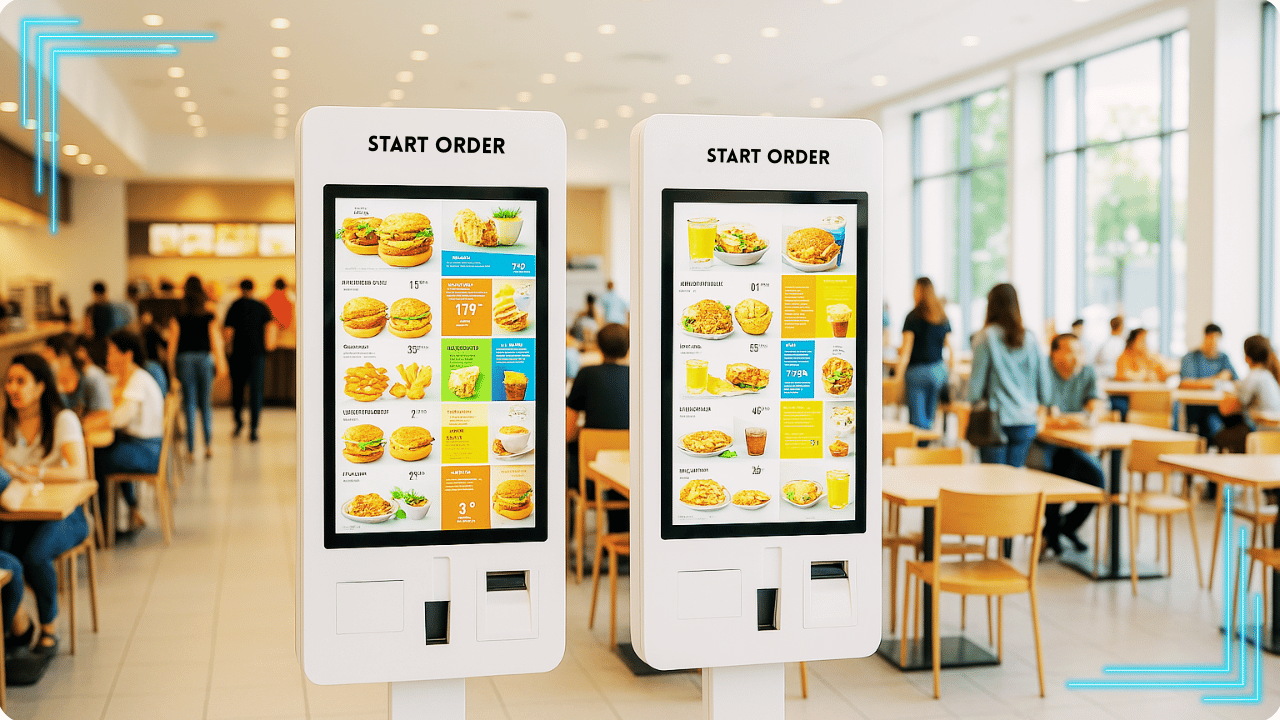
Get Your Food Service Business Ready for the Future with Self-Ordering Kiosks
What is a Self-Service Kiosk? A self-service kiosk is a touchscreen device that allows customers to place their own orders quickly, conveniently, and independently, without needing assistance from staff.
Think of it as a ‘digital waiter’: customers browse the menu, select their items, customize their order, apply coupons, pay, and complete the process right at the kiosk. Then, the order is sent directly to the kitchen system or printed at the counter, no delays, no miscommunication, no mistakes.
There are various types: large freestanding kiosks for the floor, wall-mounted kiosks, compact countertop terminals, and even portable kiosks using tablet-based systems. It all depends on the size and setup of your food service operation.
And the best part? You don’t need to be a famous brand to use them. Today, even small businesses can rent kiosks for under $200 per month, with software, support, and maintenance included.
Beyond speeding up service, kiosks give your restaurant a modern look, and customers love the sense of autonomy.
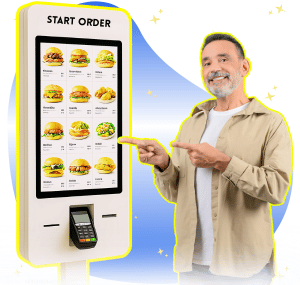
How Just a $1.20 Increase in Average Ticket Can Impact Your Revenue
It might sound small, but a $1.20 boost per order can create a major impact on your bottom line over the course of a month.
Let’s look at a realistic scenario:
Your restaurant serves around 300 people, but let’s assume just 100 customers daily, operating 30 days a month.
Each customer spends, on average, $1.20 more by using the kiosk (adding a combo, extra, dessert…).
The math is simple:
$1.20 × 100 customers × 30 days = $3,600 in extra monthly revenue.
And this happens without needing to increase foot traffic or make heavy investments in marketing. The kiosk itself automatically suggests upgrades at the right time, to the right customer.
Now imagine this over a full year:
$3,600 × 12 months = $43,200 in additional annual revenue.
All generated by a single self-service kiosk quietly working next to your counter.

How Does a Self-Service Kiosk Work in Practice?
Operating a self-service system is simple, intuitive, and designed to be user-friendly even for customers with little tech experience.
Here’s how the process works, in 5 easy steps, inside a restaurant:

The customer finds the kiosk
As soon as they enter, customers spot the kiosk (typically near the entrance, counter, or waiting area). The touchscreen displays the full menu with clear images, prices, and categories.

Interacts with the screen
With just a few taps, customers browse through menu items, read descriptions, adjust quantities, add extras, remove ingredients, and even apply promo codes — all by themselves.

Completes payment
Once the order is ready, the kiosk displays a full summary and payment options: credit card, debit card, mobile payment (Apple Pay, Google Pay), or meal cards. Many kiosks come equipped with NFC readers and QR code scanners for even faster transactions.

Order sent directly to the kitchen
After checkout, the order is automatically forwarded to the kitchen display system (KDS) or printed for preparation. No handwritten notes, no manual entry, no human errors.

Customer waits for their order number
The system generates an order number, displayed on a digital board or announced by audio. In more advanced setups, customers may also get notified via SMS, WhatsApp, or a pager once their order is ready.
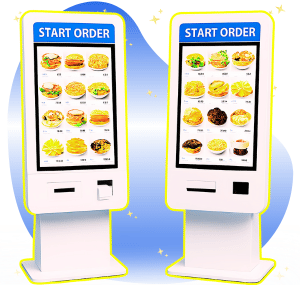
What Technologies Power Self-Service Ordering Kiosks?
The magic happens because a kiosk is much more than just a fancy screen. It combines several integrated technologies, each playing a key role in delivering a fast, secure, and efficient customer experience.
Here are the main features typically found in modern digital kiosks:
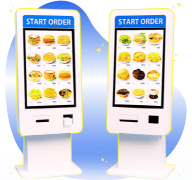
💡 Touchscreen Display
The heart of the experience. Usually between 21′ and 32′, touch-sensitive, high-quality images, responsive navigation for easy browsing.

💳 Card Reader and NFC
Allows customers to pay using physical cards or tap-to-pay with smartphones, smartwatches, or integrated payment terminals.

🧾 Thermal Printer
Prints receipts, order tickets, or pickup numbers. Some simpler models skip printing altogether, focusing on on-screen or mobile notifications instead.

📡 Full Connectivity
Kiosks connect to your restaurant system via Wi-Fi, Ethernet, or 4G, seamlessly integrating with your POS and ordering system (ERP or KDS) for real-time operations.

🔐 Secure POS System
All self-service software is installed on reliable operating systems (usually Android or Linux), with automatic updates and security protections.

📦 Digital Menu Integration
Many kiosks let you update your digital menu from an admin panel, allowing you to add or remove items, change prices, or launch promotions in real time.
All these technologies work together to deliver a fast, intuitive experience for customers and a smoother, smarter operation for your restaurant.

Real Benefits of Self-Service Kiosks for Restaurants
Now that you understand how it works, let’s get to the part that matters most: the real-world gains this technology can bring to your restaurant.
And honestly… there are many! It’s not just about ‘looking modern’, it’s about selling more, spending less, and running your operations more smoothly.

✅ Faster Service
With customers placing their own orders directly on the screen, the line moves faster. You serve more people in the same amount of time without overloading your team, especially during peak hours.

✅ Fewer Errors
No more wrong orders or missed ingredients. Customers select, confirm, and pay for exactly what they want, meaning less rework, less waste, and more satisfaction.

✅ Labor Savings
Instead of needing two or three staff just for order taking, the self-order kiosk handles much of the traffic. This helps reduce payroll costs or, at the very least, ease the pressure on your current team.

✅ Higher Average Ticket
Well-configured kiosks automatically suggest combos, add-ons, desserts, and drinks, and many customers accept on the spot. Upselling like this can increase the average ticket size by up to 20%.

✅ Modern Image
Your restaurant instantly looks more organized, up-to-date, and professional, attracting customers who value speed and self-service, especially younger generations and people in a hurry.

✅ Better Control and Insights
You gain real data on sales: what sells best, peak hours, what to keep or remove from the menu. This allows smarter, data-driven business decisions instead of guesswork.
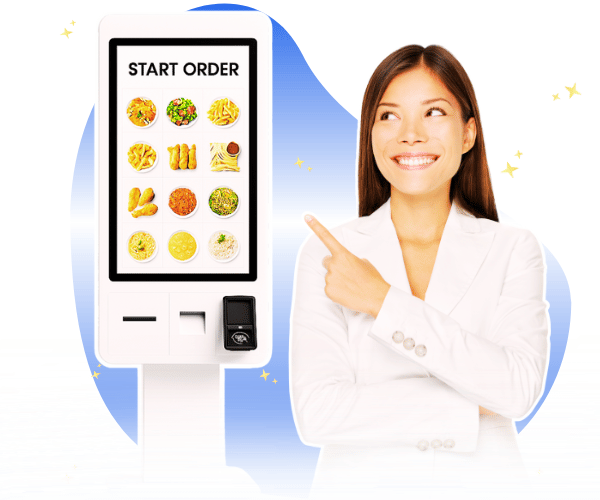
Do Self-Service Kiosks Work for Small Restaurants?
This is a common question, and the answer is: absolutely!
Today’s market offers compact kiosks with lower costs and even monthly rental options, making it easy for startups and small spaces to access this technology.
If your restaurant serves more than 40 or 50 customers a day, it can already be a great investment. You can start with one kiosk, test it out, and if it makes sense (spoiler: it will!), you can expand gradually.
Plus, suppliers often deliver a full package: kiosk + software + support + maintenance + integration with your existing system. So you don’t have to worry about installation or technical setup.

Make Your Food Service Faster and More Modern with Self-Service Kiosks
Now that you know what a self-service kiosk is, it’s easy to understand why more and more restaurants are adopting this solution. It works in real life. It delivers real results. And it’s more accessible than ever.
You can modernize your service, speed up orders, reduce lines, sell more, and project a much more professional image to your customers.
And the best part: you don’t even need a huge upfront investment. You can start with rentals, low risk, and fast returns.

FAQ
What is a self-service kiosk, and how does it help my restaurant?It’s a touchscreen device where customers place their own orders, pay, and complete the transaction without needing staff assistance. It reduces lines, order errors, and increases sales.
Does it work for small restaurants?Yes! There are compact models and rental options that fit smaller budgets. It’s an accessible solution even for local diners and small eateries.
Do I need to change my existing system?Not necessarily. Most machines can integrate with your current POS and ordering system. Just confirm compatibility with the kiosk supplier beforehand.
Can customers really use it by themselves?Absolutely. The screens are intuitive, user-friendly, with clear images, categories, and large buttons. Even those who aren’t tech-savvy can easily place an order.
Does the kiosk accept Pix and other payment methods?Yes! Modern kiosks accept debit, credit, meal vouchers, and digital wallets. Everything is handled directly at the terminal, without needing to wait at the counter.
What’s the ROI?With the increase in average ticket size and labor savings, many businesses see a return on their investment within just a few months, in some cases, in less than 4 months.

🔔 Self-Service Kiosk: How Much Does It Cost?⇗
🔔 Is a Self-Order Kiosk Worth It? Cons?⇗
🔔 7 Benefits of Self-Service Kiosks⇗
